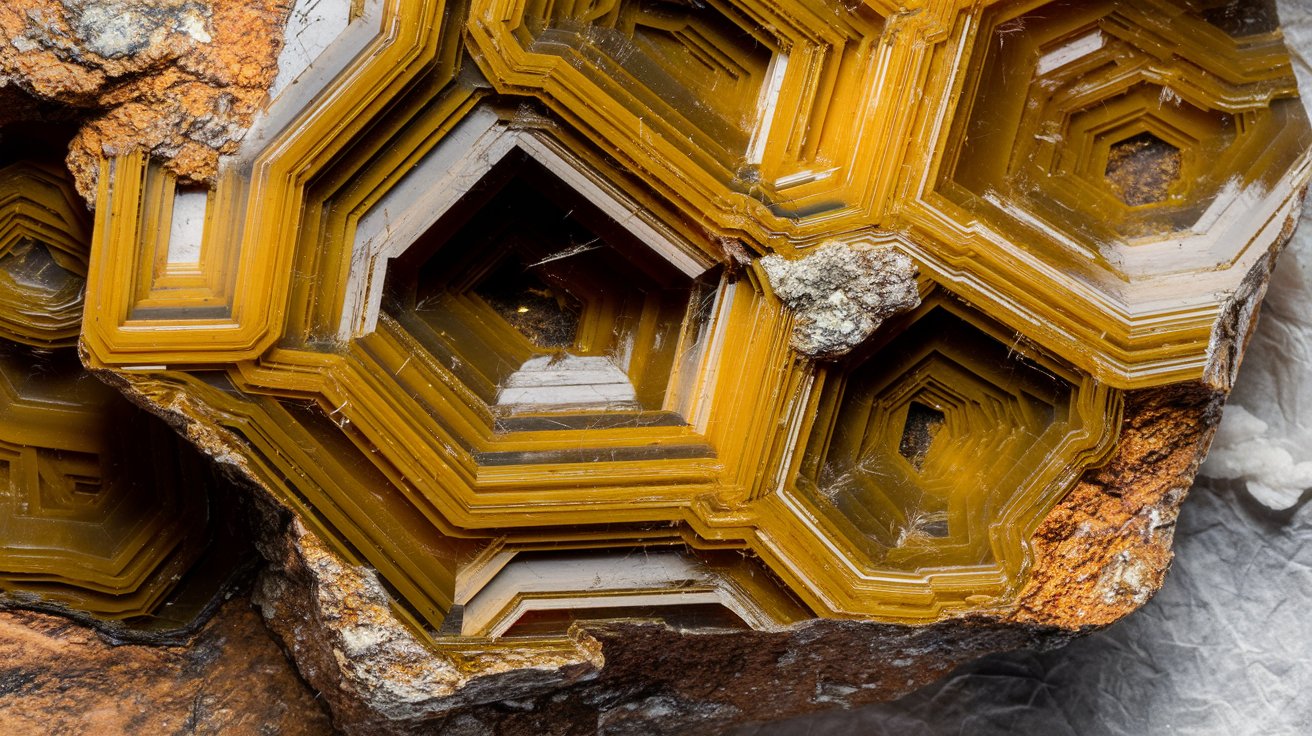
Ever heard of Alarsite? This rare mineral is a hidden gem in the world of mineralogy. With its unique composition of aluminium and arsenate, Alarsite stands out not just for its rarity but also for its intriguing properties. Found primarily in the fumaroles of the Tolbachik volcano in Russia, this mineral captures the interest of collectors and scientists alike. Its colorless to pale yellow appearance, trigonal crystal system, and vitreous luster make it a fascinating subject of study. Curious about what makes Alarsite so special? Alarsite is a mineral worth knowing about due to its unique characteristics and limited occurrence.
Key Takeaways:
- Alarsite is a rare mineral with unique properties, making it a fascinating subject for study. Its occurrence in volcanic regions and association with other minerals adds to its allure for collectors and researchers.
- Studying alarsite offers valuable insights into mineralogy, geology, and chemistry. Its rarity and cultural significance contribute to the ongoing quest for knowledge about Earth's geological heritage.
What is Alarsite?
Alarsite is a rare mineral that has piqued the interest of geologists and mineral enthusiasts alike. Its unique properties and limited occurrence make it a fascinating subject of study. Let's dive into the intriguing world of alarsite with these 30 detailed facts.
-
Composition: Alarsite is an aluminium arsenate mineral with the chemical formula AlAsO4. This means it contains aluminium, arsenic, and oxygen in a specific ratio.
-
Name Origin: The name "Alarsite" comes from its composition, highlighting the presence of aluminium and arsenate ions. This naming follows the conventions set by the International Mineralogical Association (IMA).
Crystal Structure and Physical Properties
Understanding the crystal structure and physical properties of alarsite helps in identifying and studying this rare mineral.
-
Crystal System: Alarsite crystallizes in the trigonal crystal system, which means its crystal structure exhibits three-fold symmetry.
-
Space Group: The space group of alarsite is either P3121 (number 152) or P3221 (number 154). These groups describe the specific arrangement of atoms within the crystal lattice.
-
Color and Appearance: Typically, alarsite appears colorless with pale yellow tints. It is semitransparent, allowing some light to pass through, and has a vitreous luster similar to glass.
-
Hardness: Alarsite has a Mohs hardness of 5-5.5, indicating it is relatively hard but not as hard as minerals like quartz or corundum.
-
Specific Gravity: The specific gravity of alarsite is 3.32, meaning it is denser than water, a common trait among many minerals.
-
Refractive Indices: Alarsite is optically uniaxial (+), with two refractive indices (nω = 1.596 and nε = 1.608). These indices are crucial for identifying the mineral under a polarizing microscope.
Occurrence and Geological Setting
Alarsite's rarity and specific geological settings make it a mineral of great interest to researchers.
-
Occurrence: Alarsite was first reported from fumaroles in the Tolbachik volcano, Kamchatka, Far Eastern Region, Russia. Fumaroles are vents that emit gases and minerals from volcanic activity.
-
Associated Minerals: Alarsite is often found with minerals like fedotovite, klyuchevskite, lammerite, nabokoite, atlasovite, langbeinite, hematite, and tenorite.
-
Geological Setting: The Tolbachik volcano is known for its extensive volcanic activity, creating unique environments for rare minerals like alarsite.
-
Brittle Nature: Alarsite occurs as brittle subhedral grains, meaning the crystals are not perfectly formed but have some resemblance to their ideal shape.
-
Rarity: Due to its limited occurrence in specific geological settings, alarsite is considered a rare mineral, making it highly sought after by collectors and researchers.
Classification and Identification
Classifying and identifying alarsite involves examining its chemical and physical properties.
-
Mineralogical Classification: Alarsite belongs to the class of arsenates, a group of minerals containing arsenic combined with other elements like aluminium.
-
IMA Symbol: The IMA symbol for alarsite is "Ars," used in mineralogical databases and literature for quick identification.
-
Crystal Class: The crystal class of alarsite is trigonal, reflecting its trigonal symmetry, a feature distinguishing it from other minerals with different crystal systems.
-
Identification: Identifying alarsite involves examining its color, hardness, luster, and specific gravity. Its pale yellow tints and vitreous luster help distinguish it from other minerals.
Research and Collectibility
Alarsite's rarity and unique properties make it a valuable subject for research and collection.
-
Mineralogical Database: Alarsite is listed in various mineralogical databases like Mindat.org and Webmineral.com, providing detailed information about its composition, occurrence, and properties.
-
Localities: Besides the Tolbachik volcano, other localities may report alarsite, though these occurrences are less documented and require further research.
-
Mineralogical Research: Ongoing research aims to understand the formation mechanisms of rare minerals like alarsite, helping scientists discover more such minerals.
-
Collectibility: Alarsite is highly sought after by collectors due to its rarity and unique properties, making it a prized addition to mineral collections.
-
Educational Value: Studying alarsite offers valuable insights into mineralogy, geology, and chemistry, serving as a teaching tool for understanding crystal systems and geological processes.
Scientific and Cultural Significance
Alarsite holds significance beyond its physical properties, impacting scientific research and cultural heritage.
-
Scientific Applications: Understanding alarsite's properties can have applications in materials science and geology, making it an interesting subject for study.
-
Conservation Efforts: Efforts to conserve and document mineral localities are crucial for preserving knowledge about rare minerals like alarsite.
-
Cultural Significance: Alarsite holds cultural significance for communities involved in mining and collecting, representing a connection to the natural world.
-
Historical Context: The discovery of alarsite provides historical context to the evolution of mineralogy as a scientific discipline, highlighting the continuous discovery of new minerals.
Future Prospects and Collaborative Research
The study of alarsite opens up possibilities for future discoveries and collaborative research.
-
Future Discoveries: The discovery of alarsite suggests potential future discoveries of similar minerals, encouraging continued exploration of volcanic regions and other geological settings.
-
Collaborative Research: Research into alarsite often involves collaboration between geologists, mineralogists, and chemists, ensuring a comprehensive understanding of the mineral's properties and occurrence.
-
Public Awareness: Raising public awareness about rare minerals like alarsite can inspire interest in science and nature, engaging the public in geological and mineralogical sciences.
-
Legacy: The study of alarsite leaves a lasting legacy in the scientific community, contributing to the ongoing quest for knowledge about the Earth's crust and the diverse array of minerals that make up our planet's geological heritage.
The Fascinating World of Alarsite
Alarsite, with its unique composition of aluminium arsenate, stands out in the mineral world. Found primarily in the fumaroles of Tolbachik volcano in Russia, its trigonal crystal system and space groups P3121 or P3221 make it a subject of interest for mineralogists. Its colorless to pale yellow appearance, vitreous luster, and Mohs hardness of 5-5.5 add to its allure. The specific gravity of 3.32 and optical properties further distinguish it. Often found with minerals like fedotovite and hematite, alarsite's rarity makes it a prized find for collectors. Its study offers insights into geological processes and the conditions necessary for its formation. As research continues, alarsite remains a testament to the Earth's dynamic and ever-changing nature. Whether you're a collector or a student, alarsite's story is a captivating chapter in the book of mineralogy.
Frequently Asked Questions
Was this page helpful?
Our commitment to delivering trustworthy and engaging content is at the heart of what we do. Each fact on our site is contributed by real users like you, bringing a wealth of diverse insights and information. To ensure the highest standards of accuracy and reliability, our dedicated editors meticulously review each submission. This process guarantees that the facts we share are not only fascinating but also credible. Trust in our commitment to quality and authenticity as you explore and learn with us.


